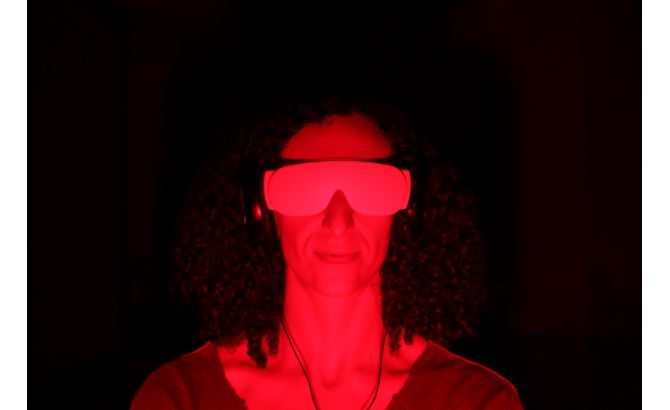Audio visual installation, single person installation, white glasses, Quicktime film, 4 min, loop, video projector, chair, headphones, 2011
Expanded version, several person installation, white glasses, Quicktime film, 4 min, loop, video projectors, chairs, headphones, matrazes, mirror, soundtrack, loudspeakers, 2017/2022
by Andrea Božić, Robert Pravda and Julia Willms
An intimate sensory environment and inverted cinema based on the Ganzfeld effect:
The visitor is asked to sit down in a comfortable chair and put on a pair of specially designed non-see-through white glasses and a pair of headphones. They keep their eyes and ears open looking in the direction of light beamed by a video projector. The projected video consists of a sequence of colours white, red, blue and black - slowly crossfading into each other, where the moment of change between the colours is imperceptible. The sound consists of thousands of sound fragments, layered over each other hundreds of time, creating a soundwave (granular synthesis). The eye sees no recognizable spatial border or shape to hold on to but uniform colour fields. The ear hears no recognizable sound related to the outside space but a continuous noise wave. Together they create a sensory deprivation environment which becomes a different kind of sensory stimulation environment.
Inverted cinema:
‘Looking outside’ becomes ‘looking inside’. The different colours are perceived as changing spatial experiences: the visitor feels like they are ‘in’ the space of the colours, rather than looking at the colours. The different colours ‘feel’ different. With the colour red, one does not know any longer if their eyes are open or closed. The sound wave changes the sense of depth and position of the viewer in space. The visitor is taken to ‘no space’: not moving from their chair but moving into a different space, becoming a part of the space themselves.
Through The Looking Glasses is based on the Ganzfeld effect.
The Ganzfeld effect is the result of the brain amplifying neural noise in order to look for the missing visual signals. The noise is interpreted in the higher visual cortex, and gives rise to hallucinations. This is similar to dream production because of the brain's state of sensory deprivation during sleep.
The Ganzfeld effect has been reported since ancient times. The adepts of Pythagoras retreated to pitch black caves to receive wisdom through their visions known as the prisoner's cinema. Miners trapped by accidents in mines frequently reported hallucinations, visions and seeing ghosts when they were in the pitch dark for days. Arctic explorers seeing nothing but featureless landscape of white snow for a long time also reported hallucinations and an altered state of mind.
A similar training is undergone by astronauts preparing for travel in outer space.
Tour: see Mars Landing tour; ICKEvent, Frascati, Amsterdam; GAM Obrist Gallery, Essen (DE); Sonic Maze Festival, Roundhouse, London (UK); Goleb, Amsterdam; Rhythm & Event, Kingston University, London (UK); Kunstfort, Vijfhuizen; Altana Kultur Stiftung, Bad Homburg (DE); Spectra Salon, Spectra Studio, Amsterdam; Burgerweeshuis / BPD, Amsterdam; Frascati, Amsterdam, GET LOST Art Route, Amsterdam; ROC TOP NDSM, Over het Ij Festival, Amsterdam; Huize Frankendael, Amsterdam; Museum Night at Huize Frankendael, Amsterdam;
Concept and installation Andrea Božić, Robert Pravda, Julia Willms Editing Julia Willms Sound Robert Pravda
Through the Looking Glasses was originally made as part of the Mars Landing project.
